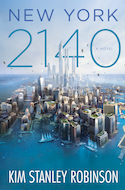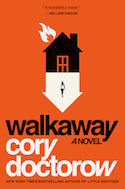The Future Alternative Past: Writers gotta write, readers gotta read
Every month, Nisi Shawl presents us with news and updates from her perch overlooking the world of science-fiction, fantasy, and horror. Read past columns here
Not what it used to be
The future science fiction depicts has never been the future. So-called Golden Age SFFH of the late 1930s to mid-1940s projected its times’ values and aesthetics onto imaginary eras flung far over the event horizon. Robert A. Heinlein’s literal space cadets, like his juvenile hero Matt Dodson, are all heterosexual men, though daringly cosmopolitan in their inclusion of differing nationalities — one of them even speaks French! Later, New Wave SFFH from the 1960s and 1970s espoused antiestablishment rebelliousness in the spirit of contemporary countercultural freakazoids like Abbie Hoffman and feminist SFFH authors including Ursula K. Le Guin and Joanna Russ pulled off populating the future widely with women-as-subjects rather than “love interests” or unattainable ideals thanks to the then-current examples of Gloria Steinem and Mary Ann Weathers. As the real-life present changesthe SFFH future does too. Because the present is what it’s based on.
Sometimes there are gaps in the projection. SFFH’s gatekeepers — publishers, editors, agents, producers, distributors, reviewers — may not feel the zeitgeist some authors are trying to represent. Or a few years pass in which features of the present that some authors want to riff off of can’t be plausibly placed in what’s called a “near-future scenario”: a setting mere decades off. You’d think doing that would be easier than making a case for far-future stuff, but no. An analogy: a character in Isaac Asimov’s story “The Ugly Little Boy” likens time travel to scratching your ear. It’s easier to do with your fingers than your elbow, though the latter’s anatomically closer. And it’s easier to posit certain changes as manifesting in a distant epoch than trying to plot out the path we’ll take between now and then.
Sometimes the continuous parade of global events or scientific discoveries renders a particular future dissonant with the resulting new present. These dissonances can accumulate: the absence of pocket calculators, cell phones, and GPS on the technological side; no trace of Brexit or Trump’s presidency on the political. Suddenly whole oeuvres, whole shelves, entire imprints lose their tenuous verisimilitude. The works of Heinlein and Asimov are obvious examples, but no writer is immune to this trap. For instance, my stories “Lazzrus” and “Sunshine of Your Love” — one published in November and the other yet to appear — mention a connection between cloning and obesity, but since I wrote about it that connection has been disproven. Stories such as mine can now only be appreciated as historical artifacts despite the dates they supposedly occur.
Social evolution also causes whole swathes of SFFH to date. Many SFFH classics impress newer readers as horribly offensive. Sexism and misogyny, racism, ableism, and other discriminatory mindsets pair frequently and unselfconsciously with more progressive and deliberately provocative attitudes; look at Bester’s The Stars My Destination and McCaffrey’s The Ship Who Sang.
What’s the solution? For us authors, the answer is to keep writing. Write some more. Write what works in the moment, and don’t worry that the moment ends, demolishing as it can your most recent futures.
Writers gotta write. Readers gotta read.
Keep reading. Keep writing. And SFFH’s futures will die only to be reborn.
Recent books recently read

Kim Stanley Robinson’s latest novel, New York 2140 (Orbit), is as large and complex as the city it’s named for. Ever optimistic, Robinson depicts a Manhattan that despite being half-drowned by melting polar ice caps rises Venice-like to meet the challenges of hurricanes and investment capital with its celebrated insouciance. The author has famously advocated for the shameless use of infodumps — those frequently lamented expository passages so often necessary to the construction of SFFH’s brave new worlds. Entire chapters of this book are nothing but. Readers who look down on infodumps can easily avoid them. Why would you want to, though? They’re relatively short and scattered through with treasures. And they blend so well with the rest of the book’s chapters, written from the viewpoints of a reality show star-cum-dirigible pilot, a pair of subversive finance software specialists, a big black cop more than a little reminiscent of the late Octavia E. Butler, and others. Viewpoint and non-viewpoint characters are fascinating, believable, and varied. Add Robinson’s vivid descriptions of natural and artificial beauty and his inventive neologisms — portmanteau words like delanyden and gehryglory — and the result is a portrait of a protean, mythical New York, a place deserving of our honor, our respect, our attention, and our lasting love.

Just as optimistically disruptive, Electronic Frontier Foundation advocate Cory Doctorow gives us Walkaway (Tor), a novel daringly bridging the gap between a highly likely near-future dystopia and a happy post-human millennium. The effortlessly involving plot follows the sexual and romantic entanglements, guerilla parties, philosophical arguments, torture, kidnapping, and escapes of a disaffected heiress with the nom de guerre Iceweasel; an outer-space-hungry cross-dresser named Kersplebedeb; Disjointed, an aging scientist working on a cure for death; and a dozen more revolutionaries. In this fictional world the word “walkaway” is both a verb and a noun. When you walkaway, you lay aside all conventional burdens and burdensome conventionality and head for a walkaway, which is an anarchic place like Hakim Bey’s Temporary Autonomous Zones, but more widespread, and supported by an impressive array of abundance tech. In contrast to what’s termed the “default,” no one works unless they want to, no one gets paid, no one starves, no one fights. How do we bring about the future we want? By living as if it’s already here, say Doctorow and those of his characters who walkaway.
Couple of upcoming cons
Sometimes cons resemble TAZs. At the International Conference on the Fantastic in the Arts last month, another attendee asked me which con was my favorite. Like at least half the people partaking in that convo I named WisCon. Certainly it’s the preeminent gathering of feminist SFFH fans in this hemisphere. Certainly it’s the most thoughtful congeries of Social Justice Warriors this side of the Inn Earnest Giraffe Emulation. And certainly I’ll be going again this year, along with my mother, who in the audience of her first James Tiptree, Jr. auction there laughed helplessly at the idea of trying to explain to her friends exactly what these whacky women were doing. (I think this was during the Titty-Shaking Duel.) You should probably go, too.
Then there’s the Nebula Conference, aka “the Nebs.” It’s a weekend of workshops, panels, and disco anthem performances, culminating in a nerve-wracking ceremonial banquet for those on the Nebula Award’s final ballot. Like me. I’ll be working a paying gig, though, so perhaps you should go in my place?